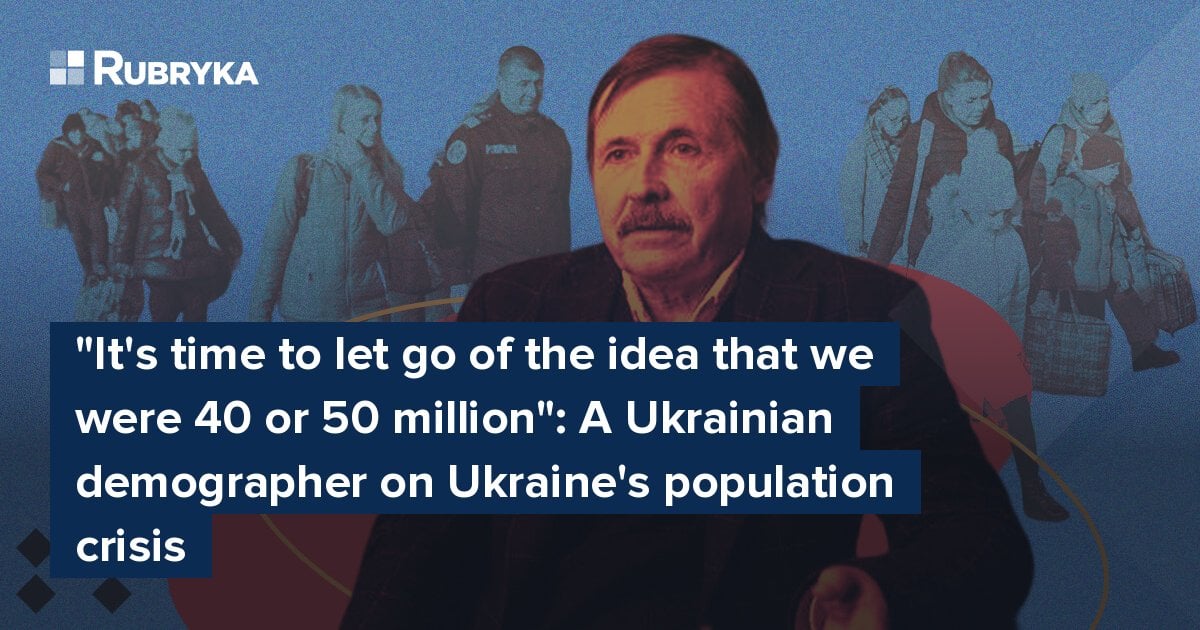
What's the problem?
What was the demographic situation in Ukraine before Russia's full-scale war?
Even before the full-scale invasion, Ukraine's demographic situation was challenging. We must also consider the impact of COVID-19 in 2020 and 2021. In 2021, COVID-19 was the second leading cause of death, directly responsible for 12.3% of all fatalities.
Looking at long-term trends, Ukraine's population peaked in 1993 at 52.2 million. By the start of the full-scale invasion, our institute estimated the population within Ukraine's 1991 [internationally recognized] borders — including Crimea and the temporarily occupied territories of Donetsk and Luhansk regions — at 42 million.
In just 30 years, the population declined by 10 million. That's an enormous rate of decline, especially considering the country continued to function and develop during this time. Unfortunately, little attention was paid to this issue.
Population decline came from three key factors:
First, low birth rates and relatively high mortality rates. Ukraine has an exceptionally high rate of premature deaths compared to other European countries. A substantial percentage of deaths occur before age 65.
Second, excess mortality among working-age men (20–60 years old). Life expectancy for men in Ukraine is 7–10 years shorter than in EU countries, and there is a 10-year gap between male and female life expectancy. In leading European nations, this gap is only 2–3 years.
Finally, the third is labor migration. Initially, migration was temporary, with people traveling to work in Europe or Russia and then returning home. Over time, many settled abroad, finding permanent jobs and housing. Experts estimate that between 1 and 2.5 million Ukrainians stayed abroad after the 2001 census. Officially, they were still counted as part of Ukraine's population, but they were no longer present in the country.
Another major issue — common globally but particularly pronounced in Ukraine — is an aging population. The proportion of people aged 60 and older has been steadily increasing.
Before the full-scale invasion, about a quarter of Ukraine's population was over 60 years old, while only 14–15% were under 15. This means fewer young people will enter the labor market over time while the proportion of retirees grows, placing pressure on the labor market, pension funds, and social infrastructure.
In short, Ukraine's demographic situation was far from good even before the invasion.

Photo: depositphotos
How has the demographic situation changed since the war began?
The full-scale invasion has only exacerbated Ukraine's existing demographic problems. Mortality rates have risen due to military deaths at the front line and civilian deaths from missile strikes and drone attacks.
Overall mortality has also increased because chronic illnesses have worsened, access to adequate medical care has become more limited, and people are living under constant stress.
Birth rates have also declined, which is a natural response to danger. This decline became particularly evident in 2024. In 2022, pregnancies were carried over from 2021; in 2023, some hoped the war would end. However, in the first half of 2024, birth rates significantly dropped. So far, we only have data for this period.
Migration has also had a significant impact. According to the UNHCR, 6.8 million Ukrainians have fled abroad. However, most experts, including those at our institute, believe this figure is inflated by 1.5–2 million based on various studies and border service data. No one can provide an exact count.
1.2–1.3 million Ukrainians are currently in Russia and Belarus, according to estimates from international organizations based on data provided by Russian authorities.
A recently published CIA report stated that Ukraine has the highest mortality rate and the lowest birth rate in the world. Is this true?
I wouldn't say that's entirely accurate, but it's not far from the truth. However, claiming we are in the most critical situation might be an exaggeration. It's no secret that mortality rates rise during war. At the same time, we can't objectively assess the actual mortality rate.
We can't even compare current statistics to those before the full-scale invasion because of the significant differences in occupied territories. The front lines keep shifting, and the Ukraine's Ministry of Justice only registers births and deaths in the areas we control. We have no idea what's happening in the areas outside of our control. The CIA's report is just an estimate; like any estimate, it has pros and cons.
Various statistical indicators measure demographic trends. One of them is the crude mortality rate, which is the number of deaths divided by the average annual population. This rate is indeed high. It was already relatively high before the war and during COVID-19 as well.
If we look at life expectancy, there are even countries in Africa where life expectancy is lower than in Ukraine, even with the war. So, it's appropriate to say that Ukraine is among the countries with the highest mortality rates, but saying we're at the top is difficult to prove objectively.
The same goes for birth rates. There's a total fertility rate, which is calculated based on the number of children born to women of reproductive age (15–49 years).
To prevent population decline, 100 women need to give birth to 210-220 children, depending on the country's mortality rate. In Ukraine, in 2021 — which was impacted by COVID-19 and affected birth rates — 100 women had 116 children. That's less than half of what's needed.
Meanwhile, in South Korea, where there's no war, 100 women give birth to 70 children. In China, it's 100 children for 100 women of reproductive age. In Japan and Italy, the number is 120. In Ukraine, during the war, about 100 women are having around 90–95 children.
Again, we can't claim that Ukraine is the worst in this area. But yes, we are among the countries with the lowest birth rates, and that's the reality. That's why I wouldn't go as far as the CIA's claim that we're at the very top of the list in both categories.

Oleksandr Hladun. Photo: RBC-Ukraine
What's the solution?
Does Ukraine need its population to grow back to 40 or 50 million?
There's no fixed number of people a country needs to thrive. Many European countries have populations of 10, 20, or 30 million people. Before the war, Ukraine had a relatively large population by European standards.
The real challenge for Ukraine is its vast territory — the largest in Europe. Such a large land area needs proper upkeep, and its population should be spread out more evenly. Without this balance, some places might be left behind or abandoned altogether.
One of the most critical tasks post-war will be redistributing the population. Which destroyed cities should be rebuilt, and which not? What to do with the border regions? Should Ukraine create a buffer zone 20 or 30 kilometers wide? All this will depend on the realities we'll face.
It will take one or two years to see how many people return from abroad after the war ends. We should not cling to our demographic past. It's time to let go of the idea that we were 40 or 50 million — we won't see this in the near future. We should assume a population of 25 to 30 million, which can serve as the foundation for economic development, rebuilding infrastructure, and forming social policies, including decisions on resettling people.
This approximate target should become the focus, and Ukraine can create social, demographic, and economic policies to stabilize this population. Natural population decline is a reality for most European countries and many world countries, where birth rates are consistently lower than death rates.
Ultimately, Ukraine's demographic future depends on its armed forces. The sooner they win the war, the better for the country and its demographic situation.
How does it work?
Can the government do anything to bring Ukrainians back?
At the moment, we can't do anything about it because migration is mainly driven by safety concerns. Until people feel safe again, they will unlikely return in large numbers.
Some people left not only because of the war but also because they were already considering moving abroad. The current situation just gave them the opportunity to leave. Whether they come back will depend on whether their host countries allow them to stay after the war.
This will create a challenge. Many European countries are interested in keeping Ukrainians, as they also face population decline. Ukrainians are educated people who want to work rather than only seek government support and are culturally compatible.
Many countries have adaptation policies for Ukrainians. The Polish have done it for over ten years, adjusting their legislation and making it easier for Ukrainians to find work legally long before the full-scale invasion. The Czech Republic and Slovakia did similar things.
Nearly all countries hosting Ukrainians have integrated them into their systems, requiring children to attend school and offering language courses for adults. So, it's hard to say how many Ukrainians will stay. As shown by the wars in the Balkans, the longer the war lasts, the fewer people are likely to return.
Right now, many different studies are being conducted, and the researchers admit that they can't guarantee that the results are fully representative. They show that around 25% of Ukrainians abroad may not return, while 25% are almost certain to return. The remaining 50% are undecided, and that's the group Ukraine should fight for.
What will they focus on when making their decision? Housing availability, job opportunities, the social status they'll have in Ukraine, and how well children have adapted abroad are factors people will weigh against their lives in their host countries. Then, they'll make a decision. We believe that if even half of those undecided choose to return, that would be a huge success.

Photo: depositphotos
Should Ukraine involve migrants from other countries?
When considering migrants, it's important to distinguish between labor market needs and demographic issues. On the labor market side, some see a noticeable shortage of workers across many sectors. All countries say that. Everyone lacks a workforce.
During the war, it could make sense to bring in migrants on work contracts to fill specific roles. Will all of these workers leave when their contracts end? I doubt it. We see it from the experience of Ukrainian migrants, who went back and forth for work and then stayed abroad.
Many Ukrainians who entered European countries without permanent residence permits now have legal status and stay there. This means many migrants who come to Ukraine for work will remain in one way or another.
At the same time, we need to consider that our soldiers will be demobilized after the war ends. There's a risk that returning soldiers and Ukrainians coming back from abroad could create a labor surplus. So, we won't be talking about a labor shortage but rather an excess of labor.
Who'll come to us to work then? Migrants are most likely to come from countries with lower quality of life than Ukraine, especially from parts of Africa and Asia. These migrants may be willing to work for lower wages than Ukrainians, which could lead to tensions or prompt more Ukrainians to seek better opportunities abroad.
It's a tricky question. Can Ukraine make use of migrant workers? I doubt it. Looking at Europe's experience, it's clear that many legal and illegal migrants end up staying in their host countries long-term, even if they initially planned to return home. Governments could not do anything about it.
If migration is seen as a way to tackle demographic issues, it should be about attracting foreigners who can eventually become citizens. These newcomers would need to settle down, marry, have children, and view Ukraine as their permanent home — not just a place to pass through. Before the war, Ukraine was often seen as a stopover, and changing this perception will require dedicated work, such as encouraging young people to study at Ukrainian universities.
Another big challenge is helping migrants adjust to a new culture and society. European countries, which promoted multiculturalism 15–20 years ago, now admit that the policy has failed. Even top European leaders acknowledge this.
When thinking about immigrants, there's always a balancing act. What can migrants contribute to the hosting country's economy, and what will they need from the said country? Often, the focus is on the economic component — a person arrives and works, and it's better for the economy. But no one considers that their family will also need social support.
Depending too heavily on migration policy involving vast numbers of foreigners isn't the right approach. Instead, Ukraine should focus on developing its own citizens. While it's unrealistic to expect a massive jump in birth rates, getting them to a sustainable level is possible. The government's policies should improve life expectancy and quality of life, keep older people in the workforce, and support families with flexible working hours, fair wages, state support, etc. Hoping foreigners can improve the situation is too optimistic.
Mortality will clearly depend on the end of the hostilities. So, the remaining issue is birth rates. What can be done to increase them?
When it comes to birth rates, things are even more complicated. Many factors influence people's decisions to have children, and each family has its reasons.
Before the full-scale invasion and the pandemic, surveys showed that most young Ukrainian families wanted two children. Now, however, the trend is more toward having just one child.
All polls show nearly the same reason behind young people's decision to have only one child: the salary. Raising children is expensive, plus housing. A family might run the risk of having one child, even if they don't have ideal housing, but not a second child.
Women also point out that they need flexible working hours, both at their jobs and in childcare. For example, preschools should offer flexible schedules so mothers can leave their kids for a few hours when it's convenient. Social infrastructure and family policies also play a big role in these decisions.
Research shows that if a family struggles financially after their first child, they're less likely to have another. On the other hand, if things go well — economically and emotionally — after the first child, they're more likely to have a second.
Birth rates are by far the most challenging of the three main factors — migration, mortality, and birth rates — and there's no quick fix. During wartime, the priority is safety, and little can be done about birth rates.
However, with the proper state policies after the war, Ukraine could reach or even exceed the average European birth rate. This would require a comprehensive, long-term plan. Unfortunately, the government focuses more on migration than on addressing birth rates.
We created this article as part of the Recovery Window Network. For more information on the recovery of war-affected regions in Ukraine, visit recovery.win
Newsletter
Digest of the most interesting news: just about the main thing





